Release Your Plans
- Daniel Sprick, American, b. 1953
- Born: Little Rock, AR
- Work Locations: Glenwood Springs, CO
Daniel Sprick was born in Little Rock, Arkansas, in 1953, and has lived off and on in Colorado since the age of five. He now lives and works in Glenwood Springs, Colorado, which gives him a “comfortable and predictable lifestyle that is right for a person to develop as an artist.”
Many of Sprick’s oil paintings, including Release Your Plans, feature an arrangement of objects set up in his studio. Some of his favorite objects show up in multiple works. He carefully selects and arranges the objects, making choices intuitively. “Mostly I paint things because I like the way things look,” says Sprick. “I have mountains of books on iconography, but iconography isn’t substantial enough. The thing has to resonate, have its own visual appeal. However, there could be some meaning in there that I don’t even know about—I’m not saying there is no meaning in there.”
While his style is very realistic, Sprick does make changes to what he sees before him, and he doesn’t limit himself to the laws of nature. He says, “I mostly see the world as a pretty good place. I guess that’s what I want to come though my work—something life affirming or some sense of well being, some optimism, some hope—even though I load it with portents of mortality and so forth. You know, I haven’t forgotten that those things exist, and I don’t think that the world is just a field of puppies romping in the daisies or anything, but it’s a good place, I just realize that there’s razor blades and cigarette butts, too.”
Sprick chose the objects in Release Your Plans simply because he likes the way they look. “That’s it. It’s not loaded with importance, it’s just that they satisfy me on some primitive level of the brain,” he says. He doesn’t like to look too hard for subject matter, because even a “cubic foot of the world contains the mysteries of the universe.” For Sprick, all kinds of things affect how a painting develops—“what’s in bloom outside at the time, what’s in the refrigerator.” The skull quickly became the focus in the painting, although he originally had something else in its place (an object that he eventually eliminated altogether). Sprick is drawn to paint bones because of how they look, saying, “I have a hard time leaving them alone because of their inherent beauty.” He tried to “play down the grim reaper a bit” by painting the skull the same color as the background so it wouldn’t stand out as much.
This piece took about four months to paint, and during that time Sprick worked on this painting only. He completed about 90% of it, however, in the first two months. Every square inch of the painting has to work for him. Sometimes he will spend up to a week working on just one part, a part that he thinks should have taken him just one day.
Details
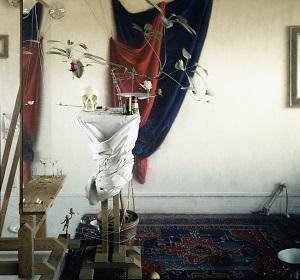
Title
The title of this painting came from an interview Sprick heard on the radio while he was working on this painting. During a fundraiser, someone said “Listen to your destiny, and when it calls, release your plans.” This message is written on the piece of paper tacked on the wall behind the easel in the painting, and the words “Listen” and “Release Your Plans” are repeated on the bottle and the soup can.

Skull
The skull first belonged to his dad, who made dentures for a living (this one has a good set of teeth). Sprick finds the skull, as well as the leg bone on the floor, visually pleasing. He’s looked at bones so much that he doesn’t associate them with feelings of death the way others might. But he does handle them with reverence, conscious that they were once part of a human being.
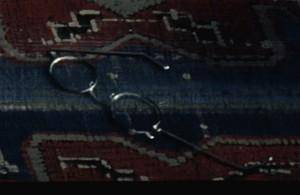
Glasses
Sprick thinks the glasses add a sense of story to the work, and he sees them as evidence of human frailty.
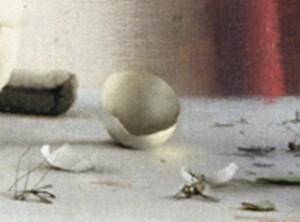
Kitchen Refuse
Sprick doesn’t have to go far to find things like eggshells, old cans, and broken bottles to paint. He likes to combine things that are beautiful with things that are not. There are usually visual qualities that appeal to him, like the sharp edge and bright white of an eggshell.
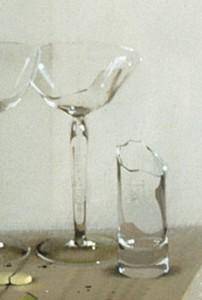
Broken Stuff
Sprick finds broken bottles and glasses especially interesting. He rescues things from the trash but says he’d never break something just to paint it.

Floating Objects
Sprick says that some objects end up floating because the support he was using (a clamp for a rose or a jar propping up a plate) didn’t look right in the layout of the painting. But he admits he also likes a bit of magic.
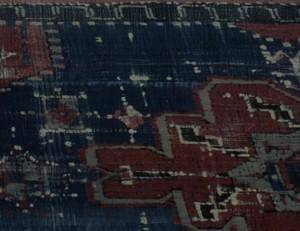
The Rug
How do you make a rug really look like a rug? By laying in the paint the same way the rug was made. Sprick’s brushstrokes followed the direction of the warp and weft (the lengthwise and crosswise threads) of the rug.
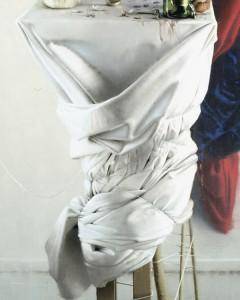
Shrouded Table
Sprick built this table specifically for use in still-life paintings. He wrapped it several times, adding more sheets underneath for bulk, and still isn’t sure he got it just right. He likes the psychological tension the string adds to the painting, but he still wonders sometimes, why wrap something up?

Cigarette Butts
Sprick says that eggshells, cigarette butts, kitchen refuse, and other debris are “testimonials to living.”
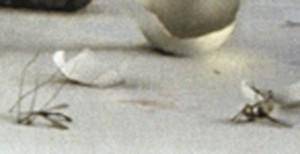
Dead Bugs
Look for the bugs on the table top. The artist actually keeps a box full of dead bugs and butterflies just to use in paintings.

Shades of White
To paint a large area with subtle shading, like the white wall, Sprick mixes all of the shades before he starts painting. He lays them out on his palette in an arrangement that reflects where they will go on in the painting. Look for shades of white that are warmer (have more yellow in them) and shades of white that are cooler (have more blue in them).
More Resources
Interview with artist Daniel Sprick
Funding for object education resources provided by a grant from the Morgridge Family Foundation. Additional funding provided by the William Randolph Hearst Endowment for Education Programs, and Xcel Energy Foundation. We thank our colleagues at the University of Denver Morgridge College of Education.
The images on this page are intended for classroom use only and may not be reproduced for other reasons without the permission of the Denver Art Museum. This object may not currently be on display at the museum.
